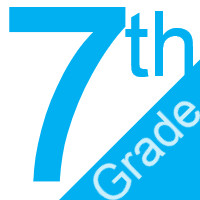ELA-07.W.01
|
7th Grade ELA Targeted Standards
(W) Writing Strand
Cluster: Text Types and Purposes
ELA-07.W.01 Write arguments to support claims with clear reasons and relevant evidence.
- a. Introduce claim(s), acknowledge alternate or opposing claims, and organize the reasons and evidence logically.
- b. Support claim(s) with logical reasoning and relevant evidence, using accurate, credible sources and demonstrating an understanding of the topic or text.
- c. Use words, phrases, and clauses to create cohesion and clarify the relationships among claim(s), reasons, and evidence.
- d. Establish and maintain a formal style.
- e. Provide a concluding statement or section that follows from and supports the argument presented.
|
Student Learning Targets for Grade 7 ELA:
Knowledge Targets
- I can define argumentative.
- I can define claim.
- I can recognize multiple sides of an issue.
- I can choose a position in an argument.
- I can identify the two sides of an argument.
- I can identify the reliability of a source.
- I can define plagiarism.
- I can identify effective transition statements.
Reasoning Targets
- I can introduce claims
- I can determine alternate or opposing claims.
- I can organize reasons and evidence in a logical manner.
- I can use valid reasoning and relevant and sufficient evidence to support a claim.
- I can organize an argument through the use of a precise introduction, well developed body paragraphs (complete with claims, counterclaims, and evidence), and a concluding paragraph that reinforces the argument, extends beyond summary, and gives finality.
- I can use logic to defend an opinion.
- I can evaluate my sources to determine if they are recent, relevant and reliable.
- I can analyze the relevancy of information. I can justify the main idea being expressed.
Skills (Performance) Targets
- I can demonstrate claims with clear reasons and credible facts.
- I can use the correct language (words or phrases) that creates and clarifies a relationship for all claims, reasons, or evidence.
- I can use a formal style.
- I can formulate an argument.
- I can demonstrate my ability to quote, summarize and paraphrase accurately to avoid plagiarism.
- I can use supporting details to support my thesis.
- I can provide at least three supporting details for a topic sentence.
- I can strengthen my argument by using relevant sources.
- I can revise my composition for correct grammar.
- I can use effective transitions in my writing.
- I can use precise and specific language and techniques.
Product Targets
- I can produce a strong written claim that supports the presented argument.
- I can develop and write an argument to support a claim using valid reasoning and relevant evidence.
- I can create a research based product from accurate and credible sources.
- I can produce a works cited page to aid in avoiding plagiarism.
Proficiency Scale for Grade 7 ELA:
| Score |
|
Description: W.7.1 - Write arguments to support claims with clear reasons and relevant evidence. |
Sample Activity
|
| 4.0 |
In addition to Score 3.0, the student effectively and independently demonstrates organized evidence of a counterargument in their paper. The counterargument is supported with apt references. |
|
| |
3.5 |
In addition to Score 3.0 performance, the student demonstrates independence as they organize counterarguments in their paper. These counterarguments rely on credible resources. |
| 3.0 |
“The Standard.” The student demonstrates no major errors or omissions regarding any of the information and processes that were end of instruction expectations.
I can
- write an argumentative paper.
- define claims.
- define argument.
- create a strong claim.
- organize evidence to support a claim.
- include relevant evidence for and against an argument.
- use credible sources.
- use transitions to clarify relationships.
- use a formal style.
- make a concluding statement.
|
See rubric below for more detail explanation of expectations.
|
|
- Take the role of a lawyer. Decide if you are either for or against Goldie locks breaking into the three bears’ house
- Choose an occupation to apply for. Decide what your setbacks are and convince the employer through a letter to hire you anyway.
- Create a top ten list to persuade.
|
| |
2.5 |
The student demonstrates no major errors or omissions regarding the simpler details and processes (Score 2.0 content) and partial knowledge of the more complex ideas and processes (Score 3.0 content). |
| 2.0 |
The student demonstrates no major errors or omissions regarding the simpler details and processes but exhibits major errors or omissions regarding the more complex ideas and processes.
There are no major errors or omissions regarding the simpler details and processes as the student:
- recognizes or recalls specific terminology, such as:
- accurate, alternate, argument, claim, clarify, clause, cohesion, concluding statement, credible, evidence, formal style, introduce, logical, opposing, organize, phrase, reason, reasoning, relationship, relevant, source, support, text, topic.
- performs basic processes, such as:
- identifying the characteristics of a model argument composition.
- writing arguments using a teacher-provided template (which includes all of the 3.0 elements).
- writing argumentative paper, but it lacks full development according to provided rubric.
|
- Quiz of terminology
- “I’m Right” game
- Graphic organizer to compile your argument
- Look at exemplar examples of writing. Define the argument and its supporting claims, concluding statement and if/what sources they used.
|
| |
1.5 |
The student demonstrates partial knowledge of the simpler details and processes (Score 2.0 content) but exhibits major errors or omissions regarding the more complex ideas and procedures (Score 3.0 content). |
| 1.0 |
With help, the student demonstrates a partial understanding of some of the simpler details and processes (Score 2.0 content) and some of the more complex ideas and processes (Score 3.0 content). |
- |
| |
0.5 |
With help, the student demonstrates a partial understanding of some of the simpler details and processes (Score 2.0 content) but not the more complex ideas and processes (Score 3.0 content). |
Grade 7: Argumentative Writing Rubric
| |
Exceeds |
Proficient |
Partially Proficient |
Novice |
| W.01.a |
Advanced skills noted: |
Introduction paragraph is organized logically and contains an attention getter, background information, acknowledgement of opposing claims, and claim/thesis.
|
Introduction paragraph lacks logical organization, is missing an attention getter or background information, or contains a weak claim/thesis. |
Introduction paragraph lacks full development. |
| W.01.b |
Advanced skills noted: |
Each body paragraph states a reason within a topic sentence and credible evidence/details that support it.
|
Body paragraphs may lack a clear topic sentence, sufficient support, or credible evidence/details. |
Body paragraphs lack full development. |
| W.01.c |
Advanced skills noted: |
Transition words/phrases and sentence variety is used to connect ideas and create clear writing.
|
Transitions are unclear and lack sentences lack variety. |
Transitions are missing and sentences are simple. |
| W.01.d |
Advanced skills noted: |
Writing consistently maintains formal style through use of third person pronouns, and by stating main points objectively (limited emotions), and avoiding contractions. |
Attempts to use third person pronouns, state main points objectively (limited emotions), avoid contractions, but this attempt at formal style may lack consistency. |
Informal style noted throughout paper. |
| W.01.e |
Advanced skills noted: |
Conclusion paragraph has a transition word or phrase, restates thesis and main points, and ends with a strong closing statement. |
Conclusion paragraph may lack a transition word, restated thesis, main points, or closing statement. |
Conclusion lacks full development. |
Resources
Websites
- Add resources with links, youtube or PDF
Vocabulary
|
 Standards Glossaries
Standards Glossaries Standards Glossaries
Standards Glossaries Standards Glossaries
Standards Glossaries Standards Glossaries
Standards Glossaries Standards Glossaries
Standards Glossaries


 Strand (W)
Strand (W)